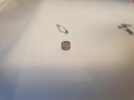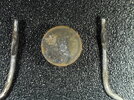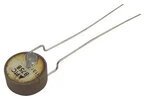It was in the power supply circuit of a time relay. The time relay is made on two HEF4541B-Q100 counters: one for setting the delay (switching frequency) the other one to control the pulse duration and thyristor for the power control. Nothing really fancy. What puzzled me is the transformerless power supply of the type I've never encountered before: no v-drop-off cap just a resistor (10k+10k+8.2k) and I didn't find where is the zener diode (but perhaps I just missed it somehow). The part which a try to identify is burned out and was connected in parallel with the drop-off resistor. The resistors (thin film judging by the color) were also burned out. I replaced the resistors and the thing sprang to life without this unknown part. By the look I would guess it is a cap but I cannot explain why would you need one at this place as before the steady state of operation is reached the cap would short-out the drop-off resistor which does not seem to me very logical.
The part is in the shape of cylinder with the diameter of: 4.7mm and the height of: 2.7mm. Before it burned out two contact legs were welded on each circular side. For more please refer to the Figs.
*** My guess: it is a PTC. I still would need more input as confirmation. In the sense that it decreases the overall resistance when the circuit is switched on so the bigger el. caps could charge quickly, later the resistance goes up to reduce the strain on the zener diode which I didn't find on the PCB ***
***

Thx in advance for everyone trying to help.
The part is in the shape of cylinder with the diameter of: 4.7mm and the height of: 2.7mm. Before it burned out two contact legs were welded on each circular side. For more please refer to the Figs.
*** My guess: it is a PTC. I still would need more input as confirmation. In the sense that it decreases the overall resistance when the circuit is switched on so the bigger el. caps could charge quickly, later the resistance goes up to reduce the strain on the zener diode which I didn't find on the PCB
Thx in advance for everyone trying to help.
Attachments
-
 timer-45-min-unknown-part-pic-2.jpeg87.9 KB · Views: 304
timer-45-min-unknown-part-pic-2.jpeg87.9 KB · Views: 304 -
 timer-45-min-unknown-part-pic-1.jpeg83.8 KB · Views: 314
timer-45-min-unknown-part-pic-1.jpeg83.8 KB · Views: 314 -
 timer-45-min-pic-1.jpeg242.3 KB · Views: 329
timer-45-min-pic-1.jpeg242.3 KB · Views: 329 -
 timer-45-min-pic-2.jpeg279.7 KB · Views: 330
timer-45-min-pic-2.jpeg279.7 KB · Views: 330 -
 timer-45-min-pic-3.jpeg254.6 KB · Views: 329
timer-45-min-pic-3.jpeg254.6 KB · Views: 329 -
 timer-45-min-unkown-part-pic-d.JPG3.7 MB · Views: 330
timer-45-min-unkown-part-pic-d.JPG3.7 MB · Views: 330 -
 timer-45-min-unkown-part-pic-c.JPG3.7 MB · Views: 331
timer-45-min-unkown-part-pic-c.JPG3.7 MB · Views: 331 -
 timer-45-min-unkown-part-pic-b.JPG3.7 MB · Views: 361
timer-45-min-unkown-part-pic-b.JPG3.7 MB · Views: 361 -
 timer-45-min-unkown-part-pic-a.JPG3.9 MB · Views: 342
timer-45-min-unkown-part-pic-a.JPG3.9 MB · Views: 342
Last edited:


